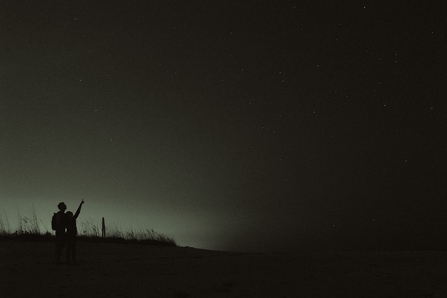I’ve never been much of a city lover – I’d always rather be somewhere away from the loud noises and bright lights. On a clear night, there’s nothing quite like being away from everything on a hill and being able to see the stars sprinkled like glitter across the sky.
In my day job as a Youth Engagement Officer with Shropshire Wildlife Trust (when I’m not sat in front of a computer screen) I’m often looking down at the little things – bugs, flowers, bees and reptiles – but looking up at the big stuff – stars, planets, nebulae, whole galaxies – has the surprising effect of making me feel grounded and connected to the life around me here on Earth. I started off my career in science communication in astronomy whilst studying astrophysics at university, and I’ve not stopped loving it.
Thinking about how small our blue dot is when viewed alongside the whole universe, and imagining all of the many millions of stars and planets that exist where there aren’t conditions for life reminds me how lucky we are to call this place home, and how none of the day to day stresses that we spend so much time and energy fretting over really matter.
Where should I go?
We’re very lucky in Shropshire to have some fantastic areas of dark sky, particularly in the south of the county and the Shropshire Hills. To get away from the worst of the light pollution of towns and cities, you don’t necessarily have to go far – go uphill above the lights and you have an even better chance of seeing more. You could head to Stiperstones or Clee Hill, but even Lyth Hill, just outside of Shrewsbury, can afford you a better view than in the town centre.
Check your local area for light pollution here: https://gostargazing.co.uk/location-light-pollution/stiperstones-car-park/
Do I need any special equipment?
A good coat, a flask of your favourite hot beverage, some snacks, and maybe a camping chair. If you have a telescope you can chuck in the back of your car, fantastic – but more often than not, a pair of binoculars which you might use in the day for birdwatching will be all you need to enhance what you can see with the naked eye. Even if you don’t have these, just taking the time to let your eyes adjust to the dark and enjoying the view can be extremely calming.
What to look for
Some things you can see all year round, and others are seasonal as we move from one side of the Sun to the other and have different parts of the sky visible at night time. Generally stargazing is an Autumn-Winter activity, as the nights are longer, so there’s more chance of getting out and still being in bed by a reasonable hour, provided you can find a cloud-free evening. But in the next few weeks over summer, you only have to be up just after midnight to see Saturn and the Moon rising, or if you’re an early bird who’s up before the Sun, you can watch Jupiter setting. One of my favourite constellations, Cygnus, the swan, is visible flying along the Milky Way, which appears like a slightly murky faint band across the sky if you’re somewhere dark enough to just see it. Apps like Stellarium (free to download on your mobile) are great for letting you know what you can see.
If you’re extra lucky, whilst you’re sitting quietly waiting for your night vision to kick in, you might even be joined by some of the wildlife that loves and relies our dark skies, from moths and bats to hedgehogs, foxes, badgers, and owls. As our cities keep expanding, some of these creatures struggle to adapt to our floodlit night time environments, so preserving these dark spaces is incredibly important for them. Just remember to keep a respectful distance whilst you sit together and enjoy the dark.


